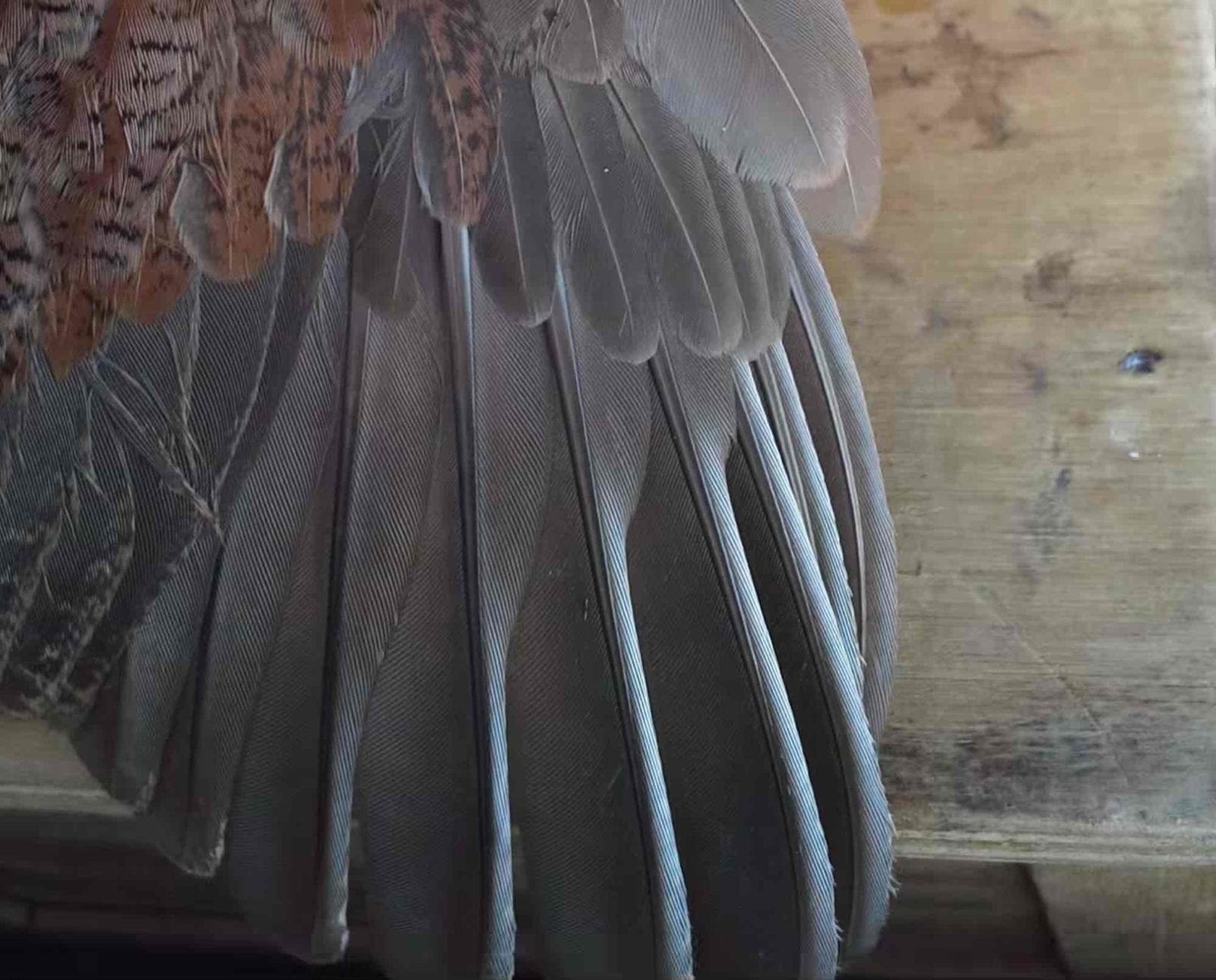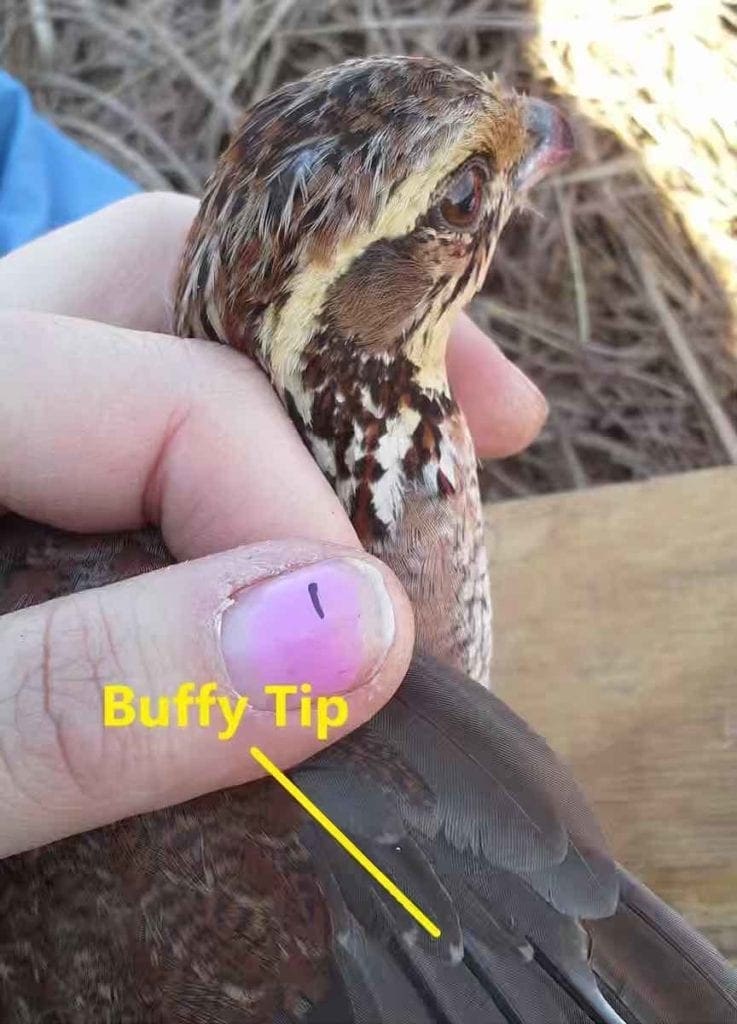Home » Quail Species » Determining the Age of a Quail from Wing Feathers
Determining the Age of a Quail from Wing Feathers

Raised in the upland bird mecca of Kansas, the passion…
Use data from feather observations to find the age of your hunted quail and identify patterns in the local bird population
Hunters throughout the uplands walk many miles each season in pursuit of various quail species. From the bobwhites in the Southeast, Gambel’s and scaled quail in the desert Southwest, Mearns and mountain quail in the hills, and California quail throughout the west, several million birds are shot on the wing, loaded in game bags, and eventually cleaned and consumed. Sure, most hunters will note the sex of each bird harvested, but there is one more piece of data that is often skipped by most hunters: aging their birds. For many game birds, distinguishing between juvenile and adult is fairly easy, and quail are no exception. In fact, quail lend themselves to determining the actual hatch date of a juvenile to within just a few days of when the bird pipped its way out of a quarter-sized egg. This information can add a bit of scientific fun for an upland junkie, but can also be useful information to help explain previous reproductive output and possibly even help guide future habitat management.
Listen to more articles on Apple | Google | Spotify | Audible
Why should I age my quail?
All quail species across North America can be identified as juvenile or adult with a simple visual inspection of the wing. A juvenile quail is one that has yet to reach one year of age. Unfortunately for quail, most never get to celebrate their first birthday.
Quail have explosive reproductive capabilities when conditions and habitat are favorable. During these ideal conditions, juvenile-to-adult ratios can reach very lopsided numbers, sometimes exceeding 15:1. My research on bobwhite quail in Missouri has demonstrated that a 6:1 juvenile-to-adult ratio represents a typical fall population during “normal” conditions. Using that as a baseline, we can age wings of harvested birds to determine the deviation from normal. A lower ratio of, say, 4:1 juveniles to adults would suggest a below-average hatch during the past summer. A ratio of 8:1 would obviously suggest the opposite; the hatch was above normal. Okay, so what? How does this affect you as a quail enthusiast?
Maybe I’m just a nerdy biologist, but I find it interesting to know as much as possible about the species I pursue, whether it’s their food preferences, behavior, or reproductive success. For bobwhites, if the ratio is lower than expected, I reflect on the previous summer. Did the area I’m hunting experience an extremely wet or dry nesting season? Was there a lack of adequate brood-rearing habitat due to a change in local land use? Most often a weather event or pattern can quickly be identified as the culprit for causing a depressed recruitment of juvenile birds into the fall population. From Missouri to Georgia, excessive rain events during June or July often result in less-than-stellar quail production. From Kansas to Texas, lack of rain during the winter and spring results in inadequate nesting and brood conditions for a quail boom. When considering Gambel’s quail, poor winter rains lead to poor reproduction. For Mearns, it’s inadequate summer rainfall. Various weather events have different effects, so the outcome depends on the particular region of the country and species of quail that you are targeting.
Age ratio data can also be used to dive a bit deeper into a local quail population. If a particular trend continues for multiple years, somewhat regardless of weather, then there is likely a habitat component influencing the ratio. For example, if you hunt a particular area that consistently has a decent population of birds but a low juvenile-to-adult ratio, that would likely indicate poor production but good adult survival. That might suggest the area has poor nesting or brood habitat, but great overwintering habitat. This can provide some ideas of where to start looking for deficiencies; if this occurs somewhere where you can influence habitat activities, perhaps make some adjustments and see if the age ratio changes in future seasons.
How to age a quail
Quail wings lend themselves to the easy aging of the bird. Each wing has various sets of feathers. There are the primary flight feathers, which are the ten outermost, long feathers that are necessary for flight. The set of long feathers between the body and the primary feathers are known as secondary flight feathers. Extending from the base of the primary feathers are a set of short feathers that cover about a third of the primary feathers, which are called primary coverts. These primary coverts indicate the age of the bird. A juvenile will have a light, buffy mark at the tip of the primary coverts. Adults will have slate grey all the way throughout the tip of the covert. This pattern holds true on all quail species across North America.

The expected ratio of juveniles to adults may differ based on location or species of quail, but the ability to discern age remains consistent. Most hunters can find the expected ratio for the area and species they hunt by contacting their state or regional quail coordinator or biologist.
Getting specific: Aging to hatch date
For those who wish to age juvenile birds down to their hatch date, quail make it fairly simple to do. All juvenile birds go through a molt and replace all of their feathers as they transition into being an adult. The primary flight feathers are replaced in a specific order from feather 1 (the shortest primary, located next to the set of secondary flight feathers) to feather 10 (the outermost feather on the wing). These feathers are replaced over time, one at a time, so that flight is never compromised. By measuring the feather being replaced, then comparing to charts that have been developed for this purpose, a hunter can discern how many days have passed since the bird hatched.
However, at least for bobwhite quail, there is a quick-and-dirty option: just add three weeks to whatever number primary is currently growing back. For example, if the sixth primary is being replaced, 6 + 3 = 9, which makes the quail around nine weeks old. This method works well through the seventh primary. The eight to ten primaries grow slower, so the accuracy is somewhat diminished. If all 10 primaries have been fully replaced, but the coverts indicated that the bird is a juvenile, then the bird is over 150 days old. In this case, the exact hatch week cannot be determined, but you can still know the bird was born before a certain date.
Keep in mind that adult birds also molt their flight feathers annually, so just because the bird is replacing a primary feather doesn’t mean it’s a juvenile. Measuring replacement feathers on adults will not provide any information regarding the possible age of the bird. The hunter must first observe the coverts to determine whether the bird was indeed hatched during the most recent summer, before examining if any feathers are being replaced.
Using quail age data to see the larger picture
Many public land hunters have likely seen wing barrels in various states, often located near parking lots at state- or federally-owned wildlife management areas. These wing barrels are important because biologists use the wings for exactly the reasons stated above. If your local area collects wings, please support those efforts. You can also call the local wildlife biologist and ask about the results from previous years’ aging efforts.
In most parts of the country, wing barrels are not used. If you want to begin aging your birds and identifying patterns, you will first need an adequate number of wings to make valid assumptions. Shooting five quail and trying to draw conclusions is unrealistic. However, 20 or more wings would be a reasonable starting point. If you don’t have big hunts with large numbers of birds, then keeping track throughout a season could lead to a respectable quantity of aged wings. Maybe this can be an excuse to hunt more next season. Set a goal to collect 50 or more wings and begin tracking your own local age data to find and identify patterns and trends in the local quail population.
Raised in the upland bird mecca of Kansas, the passion for upland birds was born at a young age for Kyle Hedges. He has now spent over 25 years managing upland game habitat on public lands in Kansas and Missouri for State Conservation Agencies. He also works as a Habitat Consultant for Land and Legacy, assisting landowners across the country with improving their properties.



